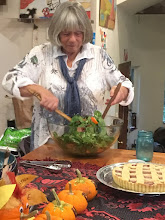I used to travel to Sweden frequently to visit my friends there and to teach at the University of Gothenburg. Whenever I was there, my friend Maren and I would make a week's excursion to a different part of Sweden. One year we traveled through the landscape of Värmland, often called the most beautiful region of Sweden, theme of the Swedish novelist Selma Lagerlöf, and the setting of her romantic novel, Gösta Berlingssaga. For most of this excursion Maren and I stayed at the summer home of a friend, a colleague at the university, so we saved money on lodging. Because we had a kitchen, we could cook meals, saving more money. For all this we reasoned that we could therefore afford to eat one dinner at the inn of Grythyttan, a small village in Värmland that had a cooking school, a renowned chef, and a restaurant touted by some as the best in Sweden. Surely it would be worth niggardly attention to our pocketbooks during the week for a splurge at such a place at week's end. So we made reservations and, on the appointed day, drove to the village.
Maren and I entered the restaurant of Grythyttan's 18th-century stagecoach inn through a small, black, wooden door that sat one step up from the cobbled street. After we were seated at a small table against the wall in a dining room with tall windows, high ceilings, and dark wood, we had a little tussle about who would drink and who would drive. I gave in when Maren said I should have the whole experience, alcohol included, because I was the foreign guest. Then we ordered our dinner, opting for the chef's suggested menu to make choices easier and figuring he knew best. While dinner was being prepared, we strolled through the beautiful old courtyard and gardens, I with my cocktail in hand.
The atmosphere of this historic inn with its Swedish 18th-century architecture and lovely gardens would alone have vindicated the cost of eating, but when it comes to expensive meals, the menu is an even more important indication of valuer per Swedish crown. For the first course we had duck liver paté with warm parsnip sauce and honey-poached pears, nicely complemented with a slightly sweet French white wine. The main course was tournedos (ox steak) with a red-wine-and-capers sauce, one long bean, and couscous with herbs and tomato. The ox, the waiter told us, had been raised on a Swedish farm, frequently visited by the chef, where all the oxen lived happily and were well cared for, presumably the reason our tournedos were so flavorful, juicy, and as tender as cake. When Maren requested—and got—more sauce, I used rather too much of it and realized the cook had not been stingy but subtle and restrained with his one splash of sauce. I was chagrined that it was I who had marred this meal that was supposed to be perfect to be worth the price. To be honest, I didn't much care for the one long green bean, either, but Maren said she didn't suppose a great deal of the price of the meal was invested in that bean. With the tournedos came a dark red California wine, smooth as velvet and absolutely superb, although my judgment of its excellence might have been influenced by West Coast chauvinism and its beautifufl dark name.
After the main course came the cheeses. One was a sheep cheese from Bredsjö, Sweden. It had won many prizes in France, the waiter told us, and was Sweden's most expensive cheese. This was not a cheap sheep cheese. There was also a two-layered cheese with a black line thought it: the ashes that separated the morning milk from the evening milk. With the cheese I was served a Swedish cloudberry wine, available only at Grythyttan.
By this time, Maren and I had been at dinner for more than two hours, and dessert was still to come: a small slice of a very rich, dark raspberry and chocolate tart, served with a Muscat Baume de Venise from Rhone, France. It would have been called perfection whatever the price.
Before we left the restaurant, I hunted up the chef de vins to tell him that I would certainly buy some of that California wine when I got back to Oregon. His face lit up. "Ah!" he said. "Oregon wines!" and he told me he often serves a pinot noir from Yamhill Vineyards in the Willamette Valley. He dashed into the cellar to grab a bottle to show me. He was so personable and good-looking I thought about suggesting he give me a call the next time he was buying wines in Oregon and I would invite him to my house, but then I thought maybe I was being unduly influenced by the food I had ingested and the wine I had imbibed, so I simply thanked him for the good meal and joined Maren for a starlit walk through the village back to our car.

No comments:
Post a Comment